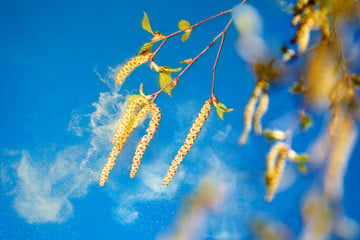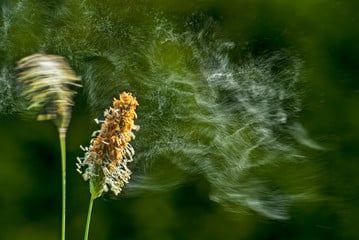Depending on the allergy sufferer, different pollen can trigger their allergies. Of the approximately 3500 plants in Switzerland, only 20 of them cause problems for pollen allergy sufferers. About 70% of those affected react to grass pollen. During the last few years, an increasing sensitization to birch and ash pollen has been observed.

The most important plants and trees from medium to very strong allergy levels are listed here.
Hazel Allergy level strong; locally large amount of pollen, first pollen in the year
Alder: Allergy level strong; locally large pollen quantity, first pollen in the year
Ash: Allergy level strong; a large amount of pollen, blooms at the same time as birch.
Birch: Allergy level very strong; most important tree pollen allergen; very large pollen production
Hornbeam: Allergy level medium; pollen quantity mostly low
Hop hornbeam: Allergy level medium; allergenic significance still unclear; cross-reaction with hazel, alder, hornbeam, and birch
Oak: Allergy level medium; symptoms occur between birch and grass blossoms; pollen quantity quite large
Beech/Red beech: Allergy level weak; pollen quantity mostly low; stronger pollen count only every 3-8 years; cross-reaction with birch.
Grasses: Allergy level very strong; grasses are the main trigger of hay fever. They form the most important pollen allergen in Switzerland; almost all grass species cause allergies.
Rye: Allergy level very strong; rye belongs to the plant family of grasses. Cross-reactions between grass and cereal pollen are very common.
Corn: Allergy level strong; corn belongs to the plant family of grasses. Corn is significant because of its cross-reaction with other grasses.
Dock: Allergy level medium; long flowering period without typical flowering maximum; pollen content in the air rather low.
Plantain: Allergy level medium; long flowering period without typical flowering maximum; pollen content in the air rather low
Mugwort: Allergy level strong; most important herb allergen
Ragweed: Allergy level very strong; ragweed, a highly allergenic plant, is related to mugwort. Only a minimum amount of pollen is needed for an allergic reaction.
Houseplants problematic for allergy sufferers
Many allergy sufferers are exposed to allergens not only outdoors, but also in their own four walls or at work, depending on the situation. Beautiful and decorative greenery can be a problem for people who are prone to allergies. Certain houseplants can irritate the skin as well as the respiratory tract, causing eczema and respiratory symptoms.
Allergic reactions have been known to occur with the following houseplants:
Birch fig Ficus Benjamina: occasionally cross-reactive with latex, respiratory reaction.
Waxflower Hoya carnosa: respiratory reaction
Ferns: respiratory reaction
Monocot Spathiphyllum Wallisii: runny nose, respiratory reaction, contact allergy
Philodendron species: respiratory reaction, contact allergy
Schefflera Ray Aralia Actinophylla/ Arbolicola: respiratory reaction, contact allergy
Yucca palm Jucca Aloifolia: contact allergy
Usambara violet Saintpaulia Ionantha hybrid: contact allergy
Poinsettia Euphorbia Pulcherrima: contact allergy
Poisonaron Dieffenbachia: contact allergy
Dragon tree Dracaena: respiratory reaction, contact allergy
Cup primrose Primula Obconica: contact allergy
Orchidaceae: contact allergy
Pollen is not always to blame for allergies to houseplants. Non-flowering houseplants can also cause hay fever-like symptoms. Birch Fig, for example, can trigger a runny nose, itchy rash, conjunctivitis, and bronchial asthma. The latex-like protein is responsible for allergies, especially for people who already suffer from latex allergies. The popular rubber tree and some cactus species also have this latex-like protein. The allergens from these plants are found in the sap of the plant, where they are transferred to the surface of the leaves through evaporation. They combine with the dust and thus become airborne.
Allergy-friendly houseplants:
- Anthuriums
- Papyrus (Cyprus grass)
- Philodendron (monster grass)
- Green Lily
- Bromeliads
- Sansevieria
- Aloe
- Zamioculcas
- in the garden area: Hydrangeas, Rhododendrons, Azaleas, Magnolias, Forsythia, and Snowball
Caution: houseplants can also be a source of dust mites and mold. Allergy sufferers should not have plants in their bedrooms.
References
- University Hospital Zurich: Allergy-causing pollen. Retrieved online 3/2/2023 from https://www.usz.ch/krankheit
- Allergy Center Switzerland: indoor plants. Retrieved online 3/2/2023 from https://www.aha.ch
- Allergy Center Switzerland: Allergenic plants. Retrieved online 3/2/2023.
- https://www.pollenundallergie.ch
- Allergy Center. Pollen: Allergen science. Retrieved online 3/2/2023 from https://www.allergiezentrum.org
- Vita24: Potted plants. Retrieved online 3/2/2023 from: https://www.24vita.de
Debora Thaler
Marketing Coordinator

